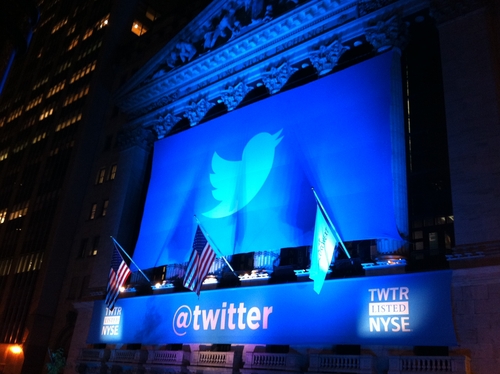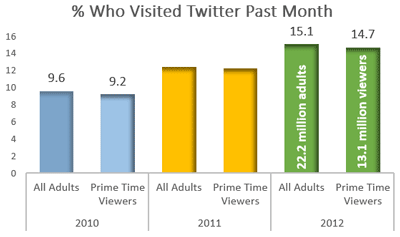It’s no wonder that broadcasters and some advertisers see Twitter as the ideal promotional partner. The Media Audit reports that nearly 15% of consumers who watch TV during prime time on a typical day have also used Twitter in the past 30 days. That’s an increase of more than 60% compared to 9.2% just two years ago. The latest figure represents more than 13.1 million consumers across The Media Audit’s 80 measured markets.

No one can say whether it will be able to monetize its social media platform, but the data suggests that TV broadcasters and cable networks have good reason to use Twitter.
It’s no wonder that broadcasters and some advertisers see Twitter as the ideal promotional partner. The Media Audit reports that nearly 15% of consumers who watch TV during prime time on a typical day have also used Twitter in the past 30 days. That’s an increase of more than 60% compared to 9.2% just two years ago. The latest figure represents more than 13.1 million consumers across The Media Audit’s 80 measured markets.
The way people watch TV is changing. More people are streaming video content and TV shows on mobile devices. Nielsen just announced that they’d be measuring phone and tablet TV viewing by mid-November. And there is a growing number of consumers who post and read tweets about popular TV shows and sporting events in real time, many of whom belong to the much-desired younger demographic. That helps to explain why advertisers and media are interested in Twitter. It lends itself to helping brands or media extend their reach to a desirable younger audience.
According to The Media Audit, Twitter represents the youngest audience for a social media platform, with an average age of 35 years. (The typical Facebook user is 40, and the average LinkedIn user is 43.) Nearly 84% of Twitter’s audience is between 18 and 49, and more than half of Twitter’s audience is under 34.
Twitter’s buying clout is also nothing to sneeze at. According to The Media Audit, Twitter users buy more cars, electronics, fast food and other goodies than the average consumer. A national study conducted among more than 7,000 Twitter users reveals they are 32% more likely to shop for a new car in the next 12 months, and 31% more likely to own fancy wheels — BMW, Mercedes, Porsche. Twitter users are 42% more likely to want fries with that and 62% more likely to buy video cameras, DVD’s, computer equipment and the like.

Cable networks have embraced Twitter, and broadcast is following.
Cable networks have embraced Twitter, and broadcast is following. The Media Audit reveals that MTV viewers use Twitter about twice as much as the rest of us, Comedy Channel viewers are 54% more likely to use it, and Bravo viewers are 34% more likely. And because they’re tweeting about the shows as they watch them, Twitter is helping to create a more participatory viewing experience.
Sports fans are no different. One in five ESPN viewers are also Twitter users —that’s 30% higher than the general population. Fans of just about every professional sport are taking to Twitter to interact with other fans, sports writers, athletes and teams as they watch live events. Among the most avid Twitter users are pro basketball fans, who are 35% more likely to use Twitter when compared to the rest of us, while pro baseball fans are 27% more likely to use Twitter.
Even news programming is affected. Twitter often serves as a real-time wire service for news media and their followers. With many national and local TV networks and affiliates heavily promoting their news content on Twitter, some local TV stations have gained significant following on Twitter. According to The Media Audit, it makes sense to use Twitter for promotion. More than one in five adults who influence business banking decisions or who are decision makers in the B2B arena use Twitter. Moreover, Twitter users are well-educated (19% more likely to have a college degree) and stock market–savvy (11% more likely to trade on the stock market).
As Twitter gets ready to become a publicly traded company, no one can say whether it will be able to monetize its social media platform. But the data suggests that TV broadcasters and cable networks have good reason to use Twitter and that it will continue to be a driving force in the TV/digital/social media convergence.
Newsletter Signup
Get our Newsletter
Sign up to receive our industry trends newsletter:
